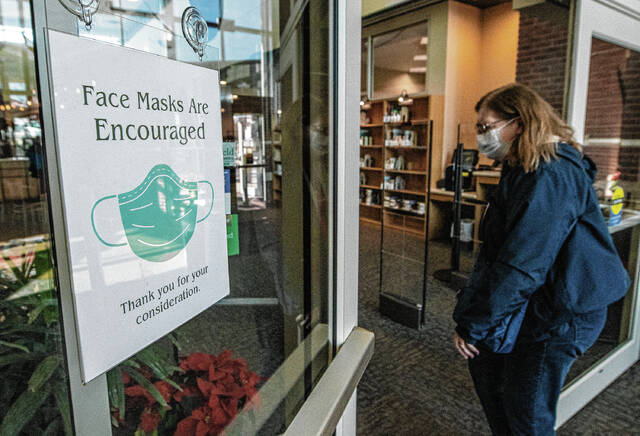
A sign posted at the front entrance to the Hancock County Public Library asks patrons to do what they can to reduce exposure to COVID-19.
Tom Russo | Daily Reporter
HANCOCK COUNTY — Surging COVID-19 infections are pushing the county’s hospital to its capacity.
The influx comes a year after the roll-out of coronavirus vaccines led medical professionals to anticipate a much different outcome.
COVID-19’s new omicron variant has also just been confirmed in Indiana as concerns rise over colder weather and holidays driving more people to gather indoors and increase the spread of the coronavirus.
Craig Felty, vice president, chief operations officer and chief nursing officer for Hancock Regional Hospital, said the hospital has had about 20 COVID-19 patients at any given time for the past several weeks. Those combined with the hospital’s other patients has brought it to its capacity.
“We’re putting patients in alternate spaces; we’re having to hold patients in the emergency department till we can get patients upstairs for beds,” Felty said. “It’s definitely a huge, huge tax on our system.”
 Craig Felty
Craig Felty
He added the hospital has even set back up overflow space on the second floor of its Gateway location at Mt. Comfort Road and Interstate 70, which it did early on in the pandemic. The hospital hasn’t had to use it yet, however, Felty said.
Hancock County has been averaging about 60 new COVID-19 cases a day, according to the Indiana Department of Health. The county recently added four more deaths from the novel coronavirus, raising its total to 194. Those recent fatalities ranged in age from 60s to 80 or older.
State health officials announced Sunday that tests confirmed Indiana’s first known case of the COVID-19 omicron variant. The infection was detected in a test sample collected from an unvaccinated Indiana resident, the Indiana Department of Health said.
Indiana was one of just seven states in which omicron had not yet been detected after first being identified last month, according to health officials.
State Health Commissioner Dr. Kristina Box said the recent omicron detection underscores the importance of COVID-19 vaccinations as people spend more time indoors and gather for holiday events.
“COVID-19 cases are on the rise across Indiana, and we do not want this variant to increase the burden on our already stressed health-care system,” Box said. “While we are still learning about omicron, we already have the tools and knowledge we need to protect ourselves and the people we love from COVID-19.”
COVID-19’s delta variant still accounts for more than 95% of U.S. cases, the Centers for Disease Control and Prevention reports. But agency leaders say omicron is spreading faster than any past variant and will become the dominant strain nationwide within weeks.
Felty thinks delta, which health officials have attributed to harsher illness, continues to be the predominant strain in Hancock County. That along with colder weather driving more people indoors and “COVID fatigue” driving less adherence to wearing masks and social distancing are creating a dangerous combination, he continued.
He also noted immunity from initial COVID-19 vaccine doses starts to wane after a while. Those 16 and older who received a Pfizer-BioNTech vaccine can get a booster at least six months after completing their primary series. Those 18 and older who received the Moderna vaccine can get a booster six months later. For Johnson &Johnson, it’s at least two months later for those at least 18.
Felty said the hospital continues to get COVID-19 patients who have been vaccinated, but they’re less ill than those who aren’t vaccinated.
“The ones who are getting really sick and the ones who are unfortunately passing are definitely predominantly the un-vaccinated,” he said.
And patients range across all ages, he continued, adding some COVID-19 deaths there have been people in their 30s and 40s.
“The ones who are sicker seem to be elderly, definitely, but for the most part this disease does not discriminate among age, for sure,” Felty said.
This time a year ago, the first COVID-19 vaccines in Hancock County were going into the arms of front-line health care workers at a clinic set up by Hancock Regional Hospital. Felty recalled the sense of a “light at the end of the tunnel” that filled that time as he and his fellow health care workers looked forward to more and more parts of the population getting vaccinated.
“That light is extremely dim, if not totally shut off,” he said. “And that’s pretty much the way that health-care professionals are feeling right now. And really, its so unnecessary that we have to be in this position that we’re in.”
The amount of Hancock County’s eligible population who are fully vaccinated remains at just over 60%, and a little over half for Indiana, according to the state health department.
“We were so excited a year ago because we know what vaccines do,” Felty said. “We study them, we have lived them our whole lives, they’re science-based. Vaccines knock out diseases, and they prevent disease from getting to exactly the point where we’re at right now. And unfortunately people just can’t get that. There’s so much misinformation out there, and we have politicized this so much.”
He couldn’t recall another time in history there was such widespread willingness to discount medical and scientific consensus.
“They’re ignoring the sources and resources that we have used as health-care providers for hundreds of years,” he said. “People are just now all of a sudden ignoring this stuff, and unfortunately there’s a lot of people out there who are losing their lives over it.
“Not getting vaccinated is a life-or-death situation for people,” he continued. “That’s what it is. You are rolling the dice. Because we know it doesn’t discriminate against age; it doesn’t discriminate against healthy people versus unhealthy people. It does what it wants to do, and people not getting the vaccine — you literally are choosing whether to live or die.”
The Associated Press contributed to this story.
COVID-19 data through early Monday, Dec. 20
Hancock County
259 new tests administered (Dec. 11-19)
45 new cases (Dec. 19)
13.3% seven-day (Dec. 7-13) positivity rate all tests, 8.8% cumulative rate
4 new deaths (Dec. 14-15)
176,824 total tests administered
14,147 total cases
22.2% seven-day (Dec. 7-13) positivity rate unique individuals, 23.2% cumulative rate
194 total deaths
45,597 fully vaccinated (62% of eligible population)
16,102 boosters
Indiana
18,842 new tests administered (April 24, 2020-Dec. 19, 2021)
2,554 new cases (Dec. 18-19)
13.5% seven-day (Dec. 7-13) positivity rate all tests, 8.9% cumulative rate
0 new deaths
16,256,290 total tests administered
1,192,448 total cases
7,547 reinfection cases since Sept. 1, 2021
25% seven-day (Dec. 7-13) positivity rate unique individuals, 25.3% cumulative rate
17,853 total deaths
49.5% ICU beds in use – non-COVID
34.5% ICU beds in use – COVID
16% ICU beds available
21.5% ventilators in use – non-COVID
13.6% ventilators in use – COVID
64.9% ventilators available
636 total probable deaths
Delta variant: 99% of samples in December
Not variant of concern: 1% of samples in December
142 total cases of multisystem inflammatory syndrome in children
3,525,616 fully vaccinated (54.2% of eligible population)
1,209,269 boosters
94,046 breakthrough cases (2.7% of fully vaccinated individuals)
1,853 breakthrough hospitalizations (0.053% of fully vaccinated individuals)
980 breakthrough deaths (0.028% of fully vaccinated individuals)




